The Use of Diffusion Weighted Imaging and Intravoxel Incoherent Motion to Assess Edema and Perfusion in Abdominal Organs during Endotoxemia
Abstract
1. Introduction
2. Materials and Methods
2.1. Randomization
2.2. Preparation
2.3. Protocol
2.4. Acquired Data
2.4.1. DW-MRI Data
2.4.2. Image Analysis
2.5. Other Data
3. Statistical Analysis
4. Results
4.1. DW-MRI Performance
4.2. Hemodynamics
4.3. Global Perfusion
4.4. Edema
5. Discussion
5.1. Perfusion and f Value
5.2. Edema and ADC
5.3. f Value and ADC in Healthy Tissues
5.4. Limitations
6. Conclusions
Author Contributions
Funding
Institutional Review Board Statement
Data Availability Statement
Acknowledgments
Conflicts of Interest
References
- Qayyum, A. Diffusion-weighted Imaging in the Abdomen and Pelvis: Concepts and Applications1. RadioGraphics 2009, 29, 1797–1810. [Google Scholar] [CrossRef] [PubMed]
- Wirestam, R.; Borg, M.; Brockstedt, S.; Lindgren, A.; Holtas, S.; Stahlberg, F. Perfusion-related parameters in intravoxel incoherent motion MR imaging compared with CBV and CBF measured by dynamic susceptibility-contrast MR technique. Acta Radiol. 2001, 42, 123–128. [Google Scholar] [CrossRef] [PubMed]
- Henkelman, R.M. Does IVIM measure classical perfusion? Magn. Reson. Med. 1990, 16, 470–475. [Google Scholar] [CrossRef] [PubMed]
- Wick, W.; Kuker, W. Brain edema in neurooncology: Radiological assessment and management. Onkologie 2004, 27, 261–266. [Google Scholar] [CrossRef] [PubMed]
- Robinson, D.; Kreitzer, N.; Ngwenya, L.B.; Adeoye, O.; Woo, D.; Hartings, J.; Foreman, B. Diffusion-Weighted Imaging Reveals Distinct Patterns of Cytotoxic Edema in Patients with Subdural Hematomas. J. Neurotrauma 2021, 38, 2677–2685. [Google Scholar] [CrossRef]
- Le Bihan, D.; Breton, E.; Lallemand, D.; Grenier, P.; Cabanis, E.; Laval-Jeantet, M. MR imaging of intravoxel incoherent motions: Application to diffusion and perfusion in neurologic disorders. Radiology 1986, 161, 401–407. [Google Scholar] [CrossRef] [PubMed]
- Koh, D.-M.; Collins, D.J.; Orton, M.R. Intravoxel incoherent motion in body diffusion-weighted MRI: Reality and challenges. AJR Am. J. Roentgenol. 2011, 196, 1351–1361. [Google Scholar] [CrossRef] [PubMed]
- Mazaheri, Y.; Afaq, A.; Rowe, D.B.; Lu, Y.; Shukla-Dave, A.; Grover, J. Diffusion-weighted magnetic resonance imaging of the prostate: Improved robustness with stretched exponential modeling. J. Comput. Assist. Tomogr. 2012, 36, 695–703. [Google Scholar] [CrossRef]
- Brandao, A.C.; Lehman, C.D.; Partridge, S.C. Breast magnetic resonance imaging: Diffusion-weighted imaging. Magn. Reson. Imaging Clin. N. Am. 2013, 21, 321–336. [Google Scholar] [CrossRef] [PubMed]
- De Cataldo, C.; Bruno, F.; Palumbo, P.; Di Sibio, A.; Arrigoni, F.; Clemente, A.; Bafile, A.; Gravina, G.L.; Cappabianca, S.; Barile, A.; et al. Apparent diffusion coefficient magnetic resonance imaging (ADC-MRI) in the axillary breast cancer lymph node metastasis detection: A narrative review. Gland Surg. 2020, 9, 2225–2234. [Google Scholar] [CrossRef]
- Sandrasegaran, K. Functional MR imaging of the abdomen. Radiol. Clin. N. Am. 2014, 52, 883–903. [Google Scholar] [CrossRef]
- Verdant, C.L.; De Backer, D.; Bruhn, A.; Clausi, C.M.; Su, F.; Wang, Z.; Rodriguez, H.; Pries, A.R.; Vincent, J.-L. Evaluation of sublingual and gut mucosal microcirculation in sepsis: A quantitative analysis. Crit. Care Med. 2009, 37, 2875–2881. [Google Scholar] [CrossRef] [PubMed]
- Marchesi, S.; Ortiz Nieto, F.; Ahlgren, K.M.; Roneus, A.; Feinstein, R.; Lipcsey, M.; Larsson, A.; Ahlstrom, H.; Hedenstierna, G. Abdominal organ perfusion and inflammation in experimental sepsis: A magnetic resonance imaging study. Am. J. Physiol. Gastrointest. Liver Physiol. 2019, 316, G187–G196. [Google Scholar] [CrossRef] [PubMed]
- du Sert, N.P.; Hurst, V.; Ahluwalia, A.; Alam, S.; Avey, M.T.; Baker, M.; Browne, W.J.; Clark, A.; Cuthill, I.C.; Dirnagl, U.; et al. The arrive guidelines 2.0: Updated guidelines for reporting animal research. PLoS Biol. 2020, 18, 9–10. [Google Scholar] [CrossRef]
- Briegel, J.; Mohnle, P. International guidelines of the Surviving Sepsis Campaign: Update 2012. Anaesthesist 2013, 62, 304–309. [Google Scholar] [CrossRef] [PubMed]
- Evans, L.; Rhodes, A.; Alhazzani, W.; Antonelli, M.; Coopersmith, C.M.; French, C.; Machado, F.R.; Mcintyre, L.; Ostermann, M.; Prescott, H.C.; et al. Surviving sepsis campaign: International guidelines for management of sepsis and septic shock 2021. Intensive Care Med. 2021, 47, 1181–1247. [Google Scholar] [CrossRef] [PubMed]
- Malbrain, M.L.N.G. Different techniques to measure intra-abdominal pressure (IAP): Time for a critical re-appraisal. Intensive Care Med. 2004, 30, 357–371. [Google Scholar] [CrossRef] [PubMed]
- Song, J.; Wang, X.; Xu, X.; Jia, B.; Zheng, Q.; Ka, W.; Sun, D.; Wen, Z.; Xie, L.; Yao, W. The effects of non-ionic contrast medium on the hemorheology in vitro and in vivo. Clin. Hemorheol. Microcirc. 2014, 58, 385–393. [Google Scholar] [CrossRef]
- Edul, V.S.K.; Ince, C.; Navarro, N.; Previgliano, L.; Risso-Vazquez, A.; Rubatto, P.N.; Dubin, A. Dissociation between sublingual and gut microcirculation in the response to a fluid challenge in postoperative patients with abdominal sepsis. Ann. Intensive Care 2014, 4, 39. [Google Scholar] [CrossRef]
- Jhanji, S.; Stirling, S.; Patel, N.; Hinds, C.J.; Pearse, R.M. The effect of increasing doses of norepinephrine on tissue oxygenation and microvascular flow in patients with septic shock. Crit. Care Med. 2009, 37, 1961–1966. [Google Scholar] [CrossRef] [PubMed]
- Lang, C.H.; Bagby, G.J.; Ferguson, J.L.; Spitzer, J.J. Cardiac output and redistribution of organ blood flow in hypermetabolic sepsis. Am. J. Physiol. 1984, 246 Pt 2, R331–R337. [Google Scholar] [CrossRef] [PubMed]
- Toya, R.; Naganawa, S.; Kawai, H.; Ikeda, M. Correlation between estimated glomerular filtration rate (eGFR) and apparent diffusion coefficient (ADC) values of the kidneys. Magn. Reson. Med. Sci. MRMS Off. J. Jpn. Soc. Magn. Reson. Med. 2010, 9, 59–64. [Google Scholar] [CrossRef]
- Ichikawa, S.; Motosugi, U.; Ichikawa, T.; Sano, K.; Morisaka, H.; Araki, T. Intravoxel incoherent motion imaging of the kidney: Alterations in diffusion and perfusion in patients with renal dysfunction. Magn. Reson. Imaging 2013, 31, 414–417. [Google Scholar] [CrossRef]
- Sigmund, E.E.; Vivier, P.-H.; Sui, D.; Lamparello, N.A.; Tantillo, K.; Mikheev, A.; Rusinek, H.; Babb, J.S.; Storey, P.; Lee, V.S.; et al. Intravoxel incoherent motion and diffusion-tensor imaging in renal tissue under hydration and furosemide flow challenges. Radiology 2012, 263, 758–769. [Google Scholar] [CrossRef] [PubMed]
- Xie, Y.; Li, Y.; Wen, J.; Li, X.; Zhang, Z.; Li, J.; Zhao, Y.; Wang, P.; Zhang, J.; Tian, Y.; et al. Functional Evaluation of Transplanted Kidneys with Reduced Field-of-View Diffusion-Weighted Imaging at 3T. Korean J. Radiol. 2018, 19, 201–208. [Google Scholar] [CrossRef] [PubMed]
- Li, Q.; Li, J.; Zhang, L.; Chen, Y.; Zhang, M.; Yan, F. Diffusion-weighted imaging in assessing renal pathology of chronic kidney disease: A preliminary clinical study. Eur. J. Radiol. 2014, 83, 756–762. [Google Scholar] [CrossRef] [PubMed]
- Andreou, A.; Koh, D.M.; Collins, D.J.; Blackledge, M.; Wallace, T.; Leach, M.O.; Orton, M.R. Measurement reproducibility of perfusion fraction and pseudodiffusion coefficient derived by intravoxel incoherent motion diffusion-weighted MR imaging in normal liver and metastases. Eur. Radiol. 2013, 23, 428–434. [Google Scholar] [CrossRef] [PubMed]
- Peng, J.; Zheng, J.; Yang, C.; Wang, R.; Zhou, Y.; Tao, Y.-Y.; Gong, X.-Q.; Wang, W.-C.; Zhang, X.-M.; Yang, L. Intravoxel incoherent motion diffusion-weighted imaging to differentiate hepatocellular carcinoma from intrahepatic cholangiocarcinoma. Sci. Rep. 2020, 10, 7717. [Google Scholar] [CrossRef]
- Zhu, J.; Zhang, J.; Gao, J.-Y.; Li, J.-N.; Yang, D.-W.; Chen, M.; Zhou, C.; Yang, Z.-H. Apparent diffusion coefficient normalization of normal liver: Will it improve the reproducibility of diffusion-weighted imaging at different MR scanners as a new biomarker? Medicine 2017, 96, e5910. [Google Scholar] [CrossRef] [PubMed]
- Lee, S.-K.; Lee, J.; Jang, S.; Lee, E.; Jeon, C.-Y.; Lim, K.-S.; Jin, Y.B.; Choi, J. Renal Diffusion-Weighted Imaging in Healthy Dogs: Reproducibility, Test-Retest Repeatability, and Selection of the Optimal b-value Combination. Front. Vet. Sci. 2021, 8, 641971. [Google Scholar] [CrossRef] [PubMed]
- Liang, P.; Chen, Y.; Li, S.; Xu, C.; Yuan, G.; Hu, D.; Kamel, I.; Zhang, Y.; Li, Z. Noninvasive assessment of kidney dysfunction in children by using blood oxygenation level-dependent MRI and intravoxel incoherent motion diffusion-weighted imaging. Insights Imaging 2021, 12, 146. [Google Scholar] [CrossRef]
- Sulkowska, K.; Palcsewski, P.; Duda-Zysk, A. Diffusion-weighted MRI of kidneys in healthy volunteers and living kidney donors. Clin. Radiol. 2015, 70, 1122–1127. [Google Scholar] [CrossRef] [PubMed]
- Ding, L.; Xiao, L.; Lin, X.; Xiong, C.; Lin, L.; Chen, S. Intravoxel Incoherent Motion (IVIM) Diffusion-Weighted Imaging (DWI) in Patients with Liver Dysfunction of Chronic Viral Hepatitis: Segmental Heterogeneity and Relationship with Child-Turcotte-Pugh Class at 3 Tesla. Gastroenterol. Res. Pract. 2018, 2018, 2983725. [Google Scholar] [CrossRef]
- Lu, B.; Yang, X.; Xiao, X.; Chen, Y.; Yan, X.; Yu, S. Intravoxel Incoherent Motion Diffusion-Weighted Imaging of Primary Rectal Carcinoma: Correlation with Histopathology. Med. Sci. Monit. Int. Med. J. Exp. Clin. Res. 2018, 24, 2429–2436. [Google Scholar] [CrossRef] [PubMed]
- Barral, M.; Eveno, C.; Hoeffel, C.; Boudiaf, M.; Bazeries, P.; Foucher, R.; Pocard, M.; Dohan, A.; Soyer, P. Diffusion-weighted magnetic resonance imaging in colorectal cancer. J. Visc. Surg. 2016, 153, 361–369. [Google Scholar] [CrossRef]
- Durayski, E.; Watte, G.; Pacini, G.S.; Roman, D.H.; Machado, M.B.; Marchiori, E.; Hochhegger, B.; Baldisserotto, M. Diffusion-weighted imaging and apparent diffusion coefficient values for evaluating terminal ileitis in patients with Crohn’s disease. Radiol. Bras. 2019, 52, 361–367. [Google Scholar] [CrossRef] [PubMed]
- Ninivaggi, V.; Missere, M.; Restaino, G.; Gangemi, E.; Di Matteo, M.; Pierro, A.; Sallustio, G.; Bonomo, L. MR-enterography with diffusion weighted imaging: ADC values in normal and pathological bowel loops, a possible threshold ADC value to differentiate active from inactive Crohn’s disease. Eur. Rev. Med. Pharmacol. Sci. 2016, 20, 4540–4546. [Google Scholar]
- While, P.T. A comparative simulation study of bayesian fitting approaches to intravoxel incoherent motion modeling in diffusion-weighted MRI. Magn. Reson. Med. 2017, 78, 2373–2387. [Google Scholar] [CrossRef]
- Kaandorp, M.P.T.; Barbieri, S.; Klaassen, R.; van Laarhoven, H.W.M.; Crezee, H.; While, P.T.; Nederveen, A.J.; Gurney-Champion, O.J. Improved unsupervised physics-informed deep learning for intravoxel incoherent motion modeling and evaluation in pancreatic cancer patients. Magn. Reson. Med. 2021, 86, 2250–2265. [Google Scholar] [CrossRef]
- Mastropietro, A.; Procissi, D.; Scalco, E.; Rizzo, G.; Bertolino, N. A supervised deep neural network approach with standardized targets for enhanced accuracy of IVIM parameter estimation from multi-SNR images. NMR Biomed. 2022, 35, e4774. [Google Scholar] [CrossRef]
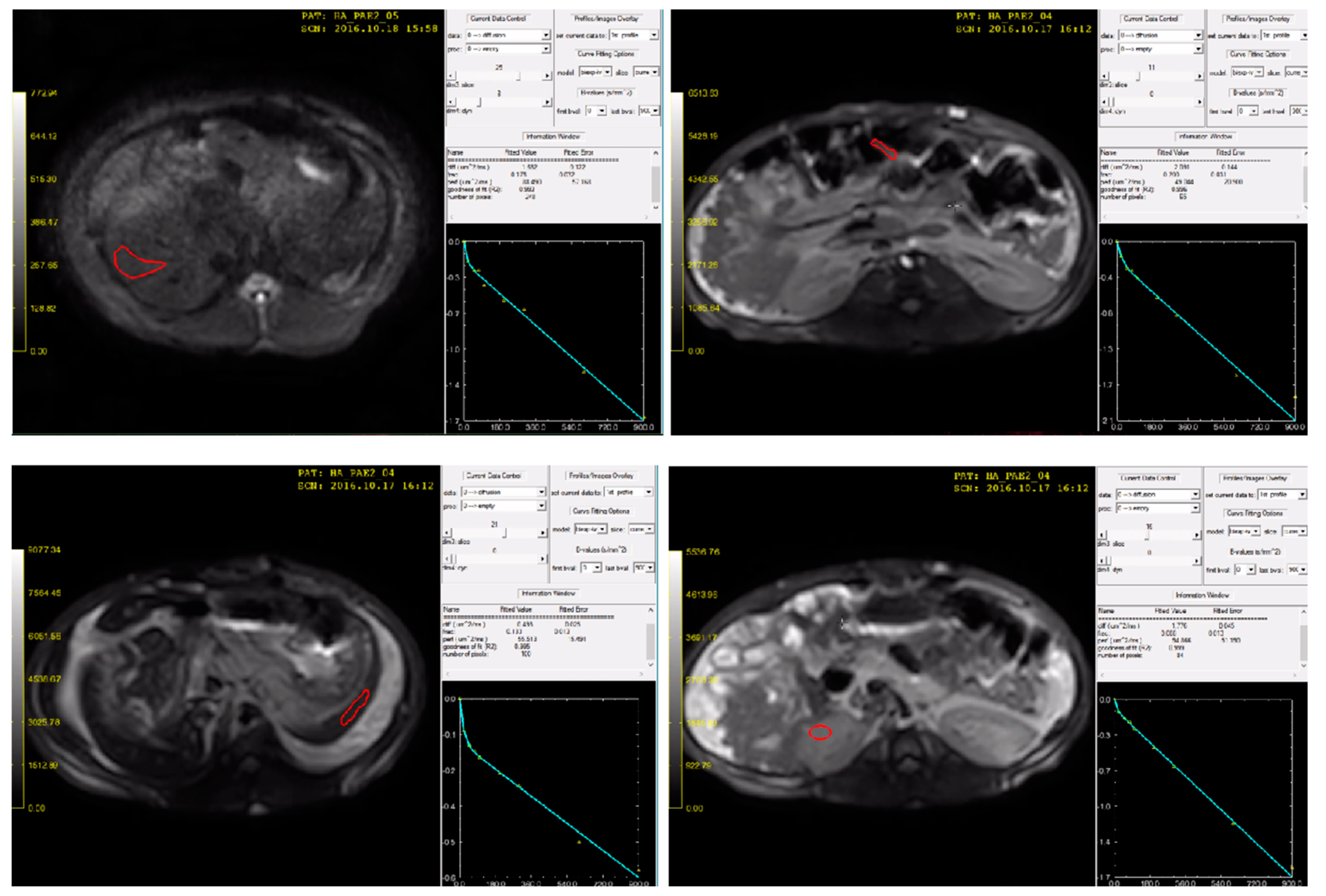
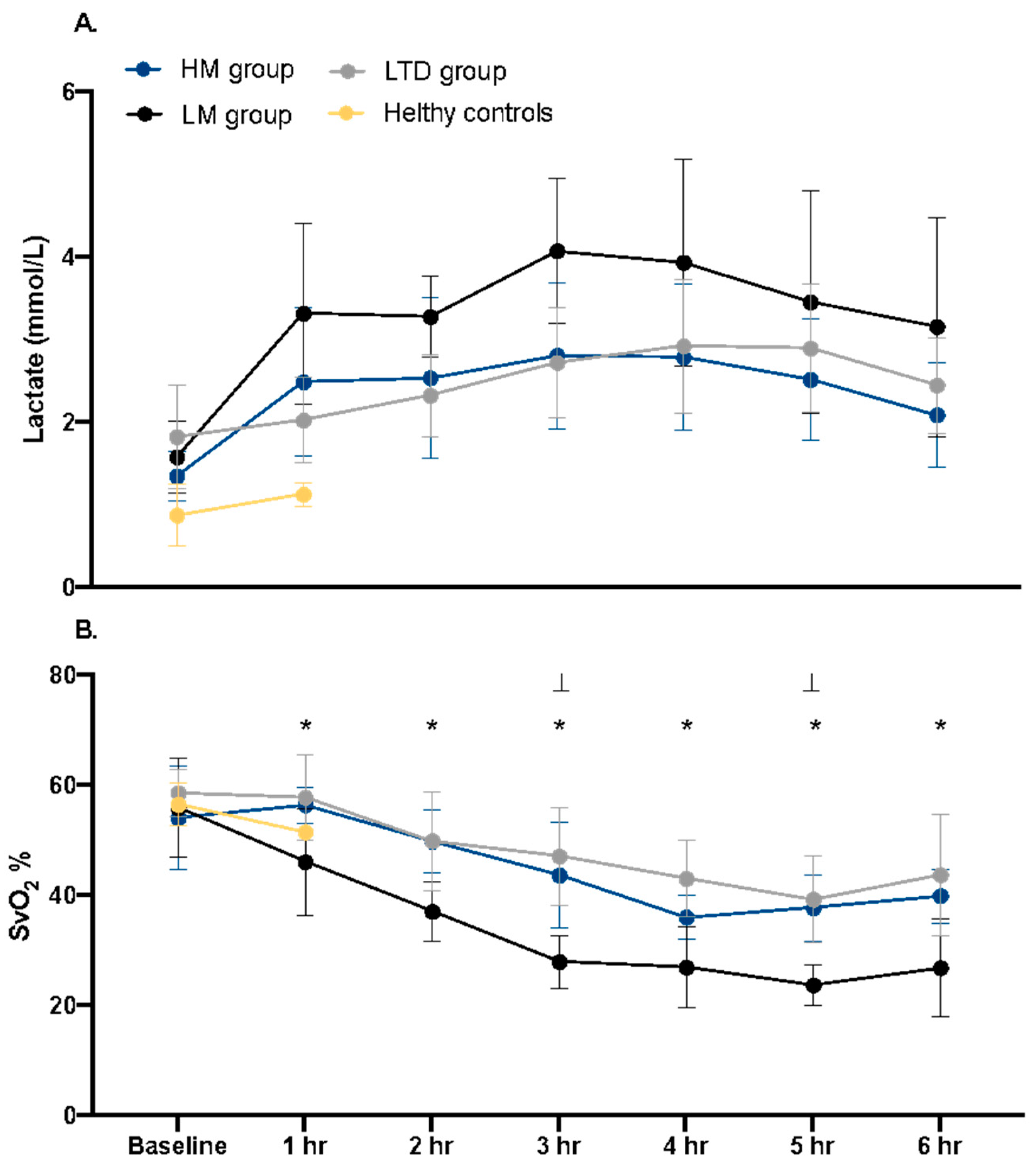
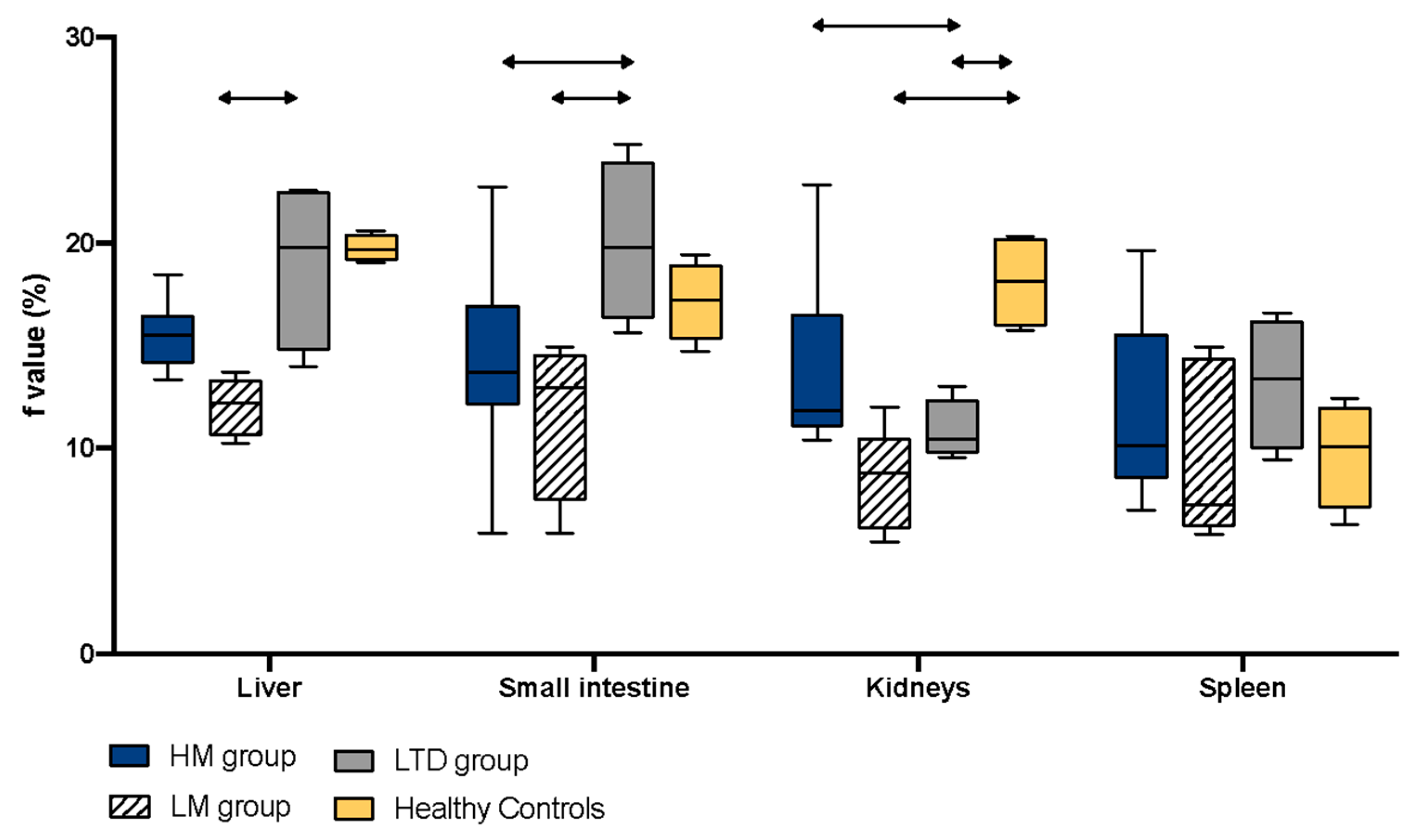
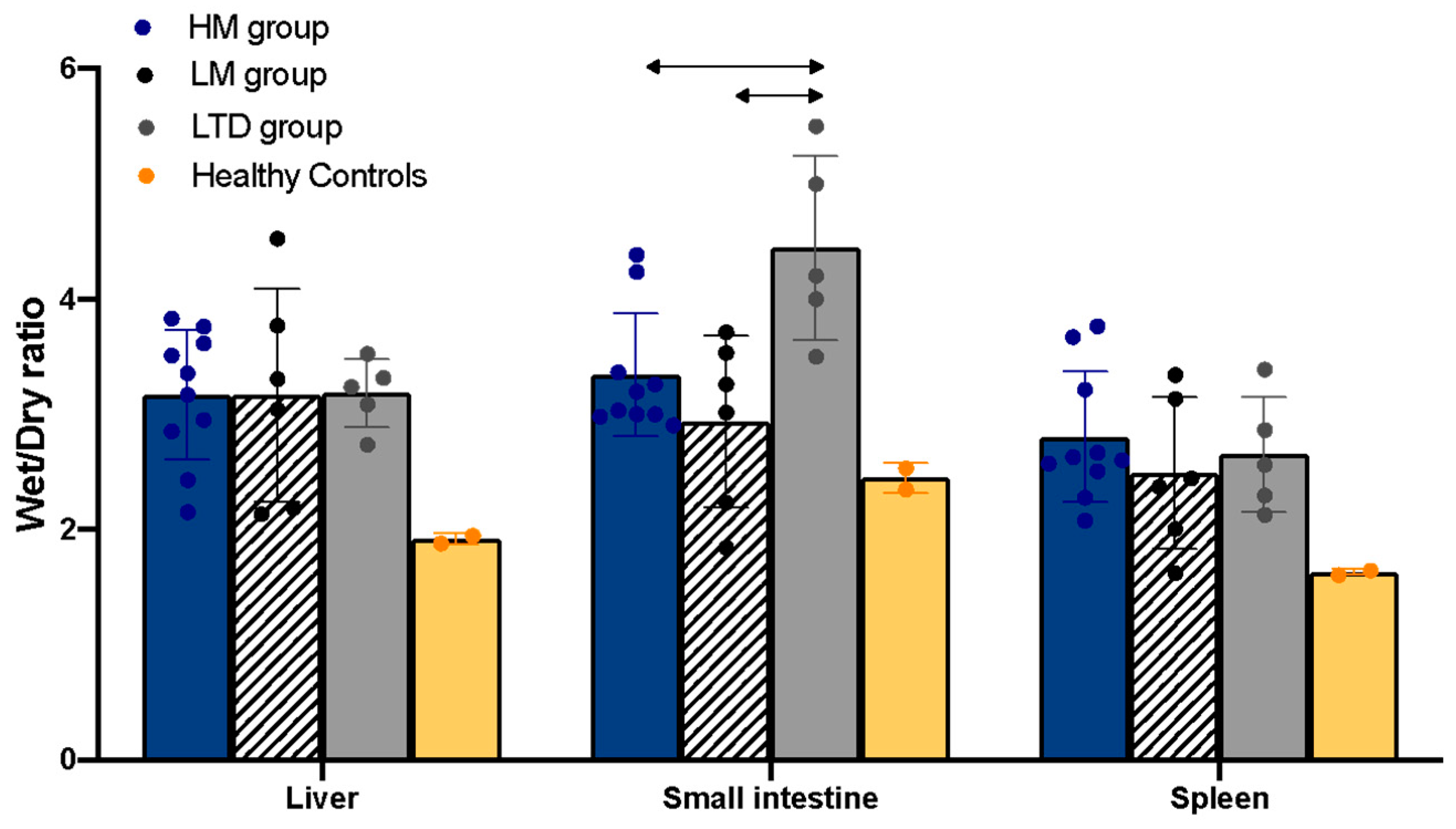

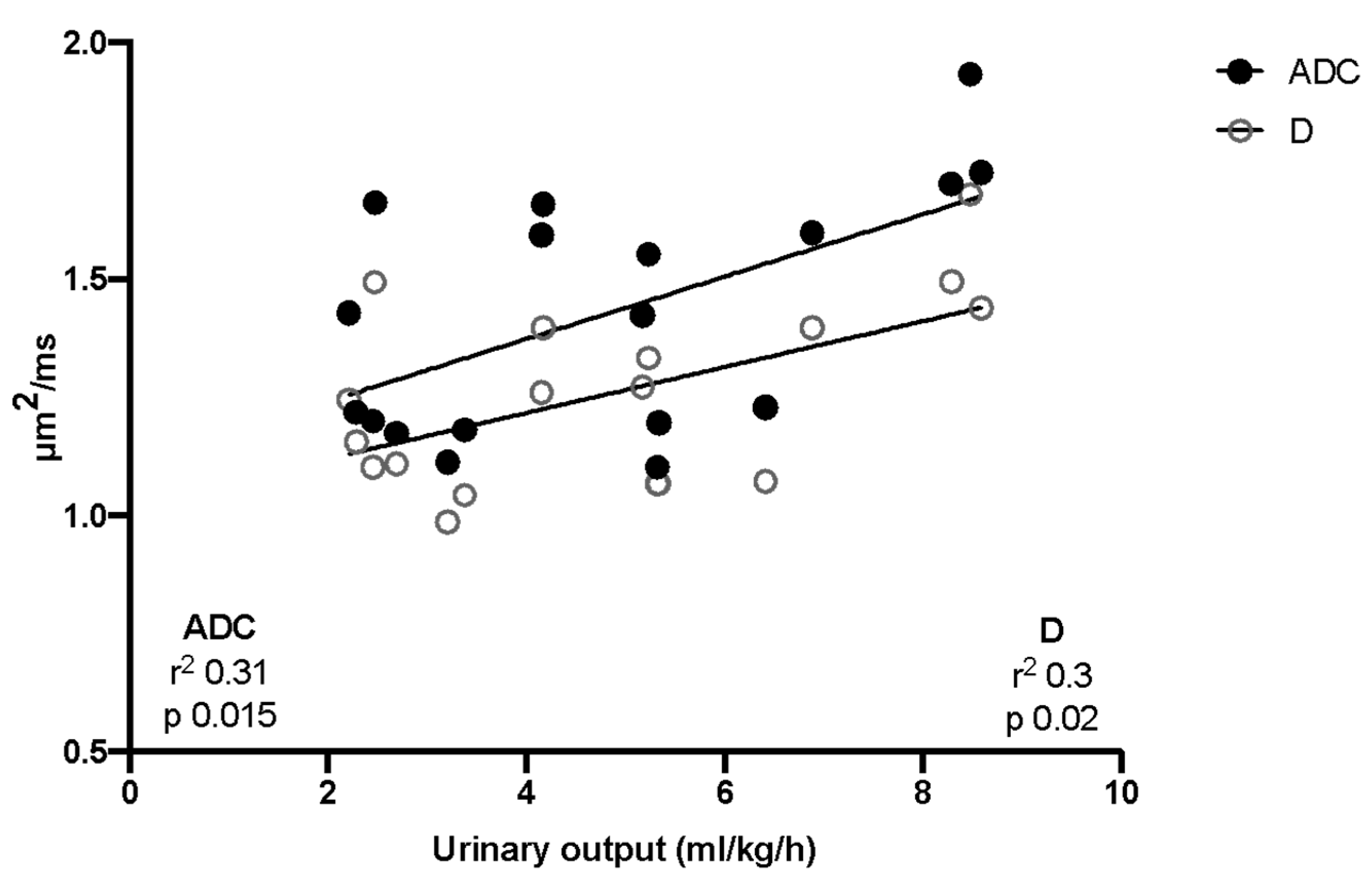
| Setting | |
|---|---|
| Field of view (FOV, right-left) | 300 mm2 |
| Pixel size | 1 mm |
| Slices | 34 |
| Slice thickness | 8 mm |
| Repetition time (TR) | 1500 ms |
| Echo time (TE) | 82 ms |
| Type of acquisition | Respiratory-triggering |
| b-values | 0; 20; 50; 75; 100; 200; 300; 600; 900 s/mm2 |
| Fat suppression | Fat saturation |
| Baseline | 1 h | 2 h | 3 h | 4 h | 5 h | 6 h | |
|---|---|---|---|---|---|---|---|
| MAP | |||||||
| HM | 83 ± 12 | 82 ± 8 | 74 ± 6 | 78 ± 8 | 83 ± 10 | 81 ± 9 | 79 ± 12 |
| LTD group | 84 ± 2 | 83 ± 12 | 69 ± 4 | 71 ± 3 | 83 ± 8 | 90 ± 10 | 86 ± 11 |
| LM group | 82 ± 17 ** | 57 ± 4 ** | 53 ± 5 ** | 52 ± 8 ** | 55 ± 6 ** | 53 ± 3 ** | 51 ± 4 ** |
| Healthy controls | 84 ± 6 | ||||||
| PAPmean | |||||||
| HM | 17 ± 3 | 34 ± 6 | 35 ± 6 | 39 ± 8 | 37 ± 6 | 33 ± 6 | 32 ± 5 |
| LTD group | 21 ± 3 | 30 ± 6 | 32 ± 3 | 40 ± 5 | 41 ± 3 | 39 ± 5 | 37 ± 7 |
| LM group | 17 ± 2 | 30 ± 6 | 31 ± 7 | 34 ± 7 | 29 ± 6 | 26 ± 5 | 25 ± 5 |
| CVP | |||||||
| HM | 7 ± 3 | 10 ± 3 | 11 ± 3 | 10 ± 2 | 11 ± 2 | 11 ± 2 | 11 ± 3 |
| LTD group | 9 ± 1 | 10 ± 2 | 11 ± 1 | 11 ± 2 | 12 ± 1 | 12 ± 1 | 12 ± 2 |
| LM group | 5 ± 3 | 9 ± 3 | 9 ± 3 | 8 ± 3 | 9 ± 3 | 9 ± 3 | 9 ± 3 |
| IAP | |||||||
| HM | 8 ± 3 | 12 ± 7 | 12 ± 5 | 13 ± 4 | 13 ± 4 | 12 ± 4 | 11 ± 4 |
| LTD group | 10 ± 3 | 12 ± 4 | 13 ± 4 | 14 ± 4 | 13 ± 5 | 12 ± 3 | 11 ± 4 |
| LM group | 9 ± 4 | 9 ± 4 | 11 ± 5 | 10 ± 4 | 9 ± 3 | 12 ± 3 | 10 ± 3 |
| CO | |||||||
| HM | 2.3 ± 0.4 | 2.1 ± 0.4 | 2.1 ± 0.5 | 1.9 ± 0.6 | 1.5 ± 0.2 | 1.6 ± 0.4 | 1.7 ± 0.3 |
| LTD group | 2.9 ± 0.4 | 2.4 ± 0.6 | 2.4 ± 0.6 | 2.2 ± 0.6 | 1.9 ± 0.4 | 1.8 ± 0.3 | 1.7 ± 0.3 |
| LM group | 2.5 ± 0.8 | 1.9 ± 0.4 | 1.7 ± 0.3 | 1.5 ± 0.2 | 1.4 ± 0.3 | 1.3 ± 0.1 | 1.4 ± 0.3 |
| Heart rate | |||||||
| HM | 83 ± 12 | 93 ± 10 | 106 ± 20 | 120 ± 20 | 110 ± 13 | 110 ± 13 | 113 ± 15 |
| LTD group | 80 ± 5 | 77 ± 13 | 91 ± 19 | 103 ± 16 | 102 ± 15 | 92 ± 15 | 92 ± 6 |
| LM group | 97 ± 22 | 116 ± 16 ** | 137 ± 27 | 140 ± 32 | 130 ± 22 | 116 ± 17 | 113 ± 13 |
| Healthy controls | 84 ± 12 | ||||||
| APP | |||||||
| HM | 78 ± 14 | 70 ± 11 | 60 ± 9 | 65 ± 11 | 70 ± 13 | 70 ± 9 | 69 ± 15 |
| LTD group | 74 ± 0.5 | 72 ± 11 | 57 ± 4 | 58 ± 4 | 70 ± 9 | 76 ± 7 | 74 ± 10 |
| LM group | 77 ± 20 ** | 47 ± 8 ** | 44 ± 6 ** | 40 ± 8 ** | 44 ± 8 ** | 43 ± 4 ** | 45 ± 6 ** |
Disclaimer/Publisher’s Note: The statements, opinions and data contained in all publications are solely those of the individual author(s) and contributor(s) and not of MDPI and/or the editor(s). MDPI and/or the editor(s) disclaim responsibility for any injury to people or property resulting from any ideas, methods, instructions or products referred to in the content. |
© 2023 by the authors. Licensee MDPI, Basel, Switzerland. This article is an open access article distributed under the terms and conditions of the Creative Commons Attribution (CC BY) license (https://creativecommons.org/licenses/by/4.0/).
Share and Cite
Marchesi, S.; Lundström, E.; Ahlström, H.; Lipcsey, M. The Use of Diffusion Weighted Imaging and Intravoxel Incoherent Motion to Assess Edema and Perfusion in Abdominal Organs during Endotoxemia. Magnetochemistry 2023, 9, 58. https://doi.org/10.3390/magnetochemistry9020058
Marchesi S, Lundström E, Ahlström H, Lipcsey M. The Use of Diffusion Weighted Imaging and Intravoxel Incoherent Motion to Assess Edema and Perfusion in Abdominal Organs during Endotoxemia. Magnetochemistry. 2023; 9(2):58. https://doi.org/10.3390/magnetochemistry9020058
Chicago/Turabian StyleMarchesi, Silvia, Elin Lundström, Håkan Ahlström, and Miklós Lipcsey. 2023. "The Use of Diffusion Weighted Imaging and Intravoxel Incoherent Motion to Assess Edema and Perfusion in Abdominal Organs during Endotoxemia" Magnetochemistry 9, no. 2: 58. https://doi.org/10.3390/magnetochemistry9020058
APA StyleMarchesi, S., Lundström, E., Ahlström, H., & Lipcsey, M. (2023). The Use of Diffusion Weighted Imaging and Intravoxel Incoherent Motion to Assess Edema and Perfusion in Abdominal Organs during Endotoxemia. Magnetochemistry, 9(2), 58. https://doi.org/10.3390/magnetochemistry9020058






